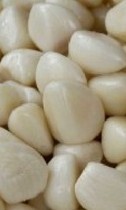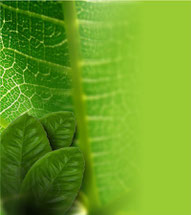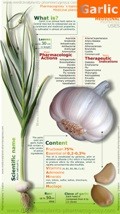Medicinal use of garlic
Medicinal uses of garlic. Indications and contraindications of garlic use.
Indications of garlic use

The biological activity of garlic is as shown: amebicide, antibacterial, acaricide, antibacterial, emmenagogue, antispasmodic, immunostimulatory, vasodilator, expectorant and
antiasthmatic.
There are also results in hypertension, hyperlipidemia, atherosclerosis, arterial disease, intermittent claudication, retinopathy. Garlic is effective in preventing
thromboembolism and hyperuricemia and contributes in the treatment of diabetes.
Another use of garlic is in the treatment of genitourinary disorders such as cystitis, ureteritis, urethritis, pyelonephritis, urolithiasis due to the allicin and its derivatives are excreted to a large degree renally.
Uses of garlic in respiratory conditions: Flu, colds, sinusitis, pharyngitis, bronchitis, emphysema, asthma.
In the digestive tract garlic is used for intestinal parasites and amoebic dysentery prevention. In topical use: Dermatomycoses, periodontal disease, hyperkeratosis.
Small doses help digestion. For chest conditions can take a clove of garlic with milk. In India the natives use drops in small doses to fight deafness. There are references to
their use in the treatment of tuberculosis. The infusion of garlic was used against cholera and scurvy. In dermal applications has been used for scabies and ringworm.
Contraindications in garlic uses

Garlic should be used with caution in hyperthyroidism, active bleeding, pre and post-operative, thrombocytopenia, warfarin-type anticoagulant therapy or hemostatic (especially extractive forms), gastroduodenal ulcers.
Do not give excessively to children under 10 years. Garlic consumption due to drusen oxalates, may produce gastrointestinal irritation. For external use can
cause contact dermatitis, due to its vesicant effect.
The pure essential oil can cause nausea, vomiting, diarrhea, diaphoresis, menorrhagia and spinal epidural hematoma. Garlic interacts actions of antihypertensives and
anticoagulants and drugs that inhibit hepatic metabolism. Use cautiously with cimetidine, ciprofloxacin, erythromycin, fluorxacina, ketoconazole, paroxetine, imipramine, phenytoin and
propranolol.
Internal use
Consume preferably at mealtime or near them.
- Raw Garlic: 1-4 cloves a day.
- Garlic Powder : 1-3 g / day, 300-500 mg capsules.
- Fluid Extract (1:1): 30 to 50 drops, one to three times daily.
- Tincture of garlic (1:5): 50 to 100 drops, twice or three times daily.
- Dry extract (5:1): 100-200 mg, 1-3 times daily.
Recommended dosage:
- Prophylaxis of atherosclerosis (Adults): 6-10 mg daily of alliin (approx. 3-5 mg of allicin, equivalent to a clove of garlic or 0.5-1 g garlic powder).
- Respiratory Conditions: 2-4 g powder or 2-4 ml of tincture 1:5, three times daily.
Topical use
- Essential oil, oily or alcoholic solution.
- Fresh Garlic: Commonly applies a slice of fresh garlic on hyperkeratotic areas, especially plantar warts and calluses. Are
recommended to protect surrounding areas with Vaseline to prevent skin irritation.
- Vaginal ovules (vaginal candidiasis): 500 mg dry extract / ovule. An ovule every night (Peris, 1995).
REMEMBER to always consult your doctor before combining natural products with any other treatment.
see also
Garlic (General characteristics)
Garlic content (active ingredients)
Infographic
summary characteristics and properties of Garlic.
Click on the image to see...
Other medicinal plants
Medicinal uses of garlic. Indications and contraindications of garlic use.

 Pharmacognosy´s topics - Medicinal plants
Pharmacognosy´s topics - Medicinal plants



Write a comment